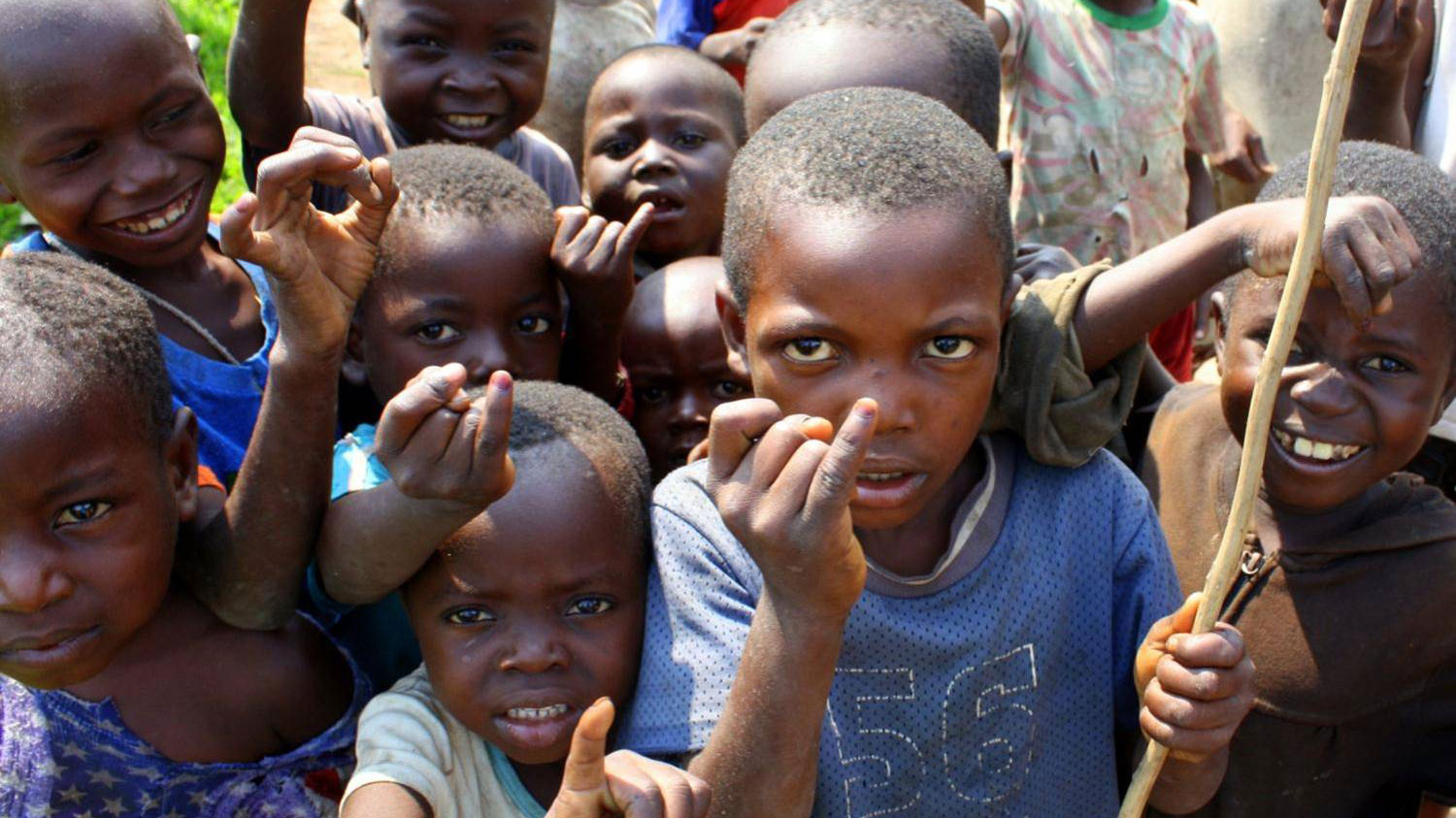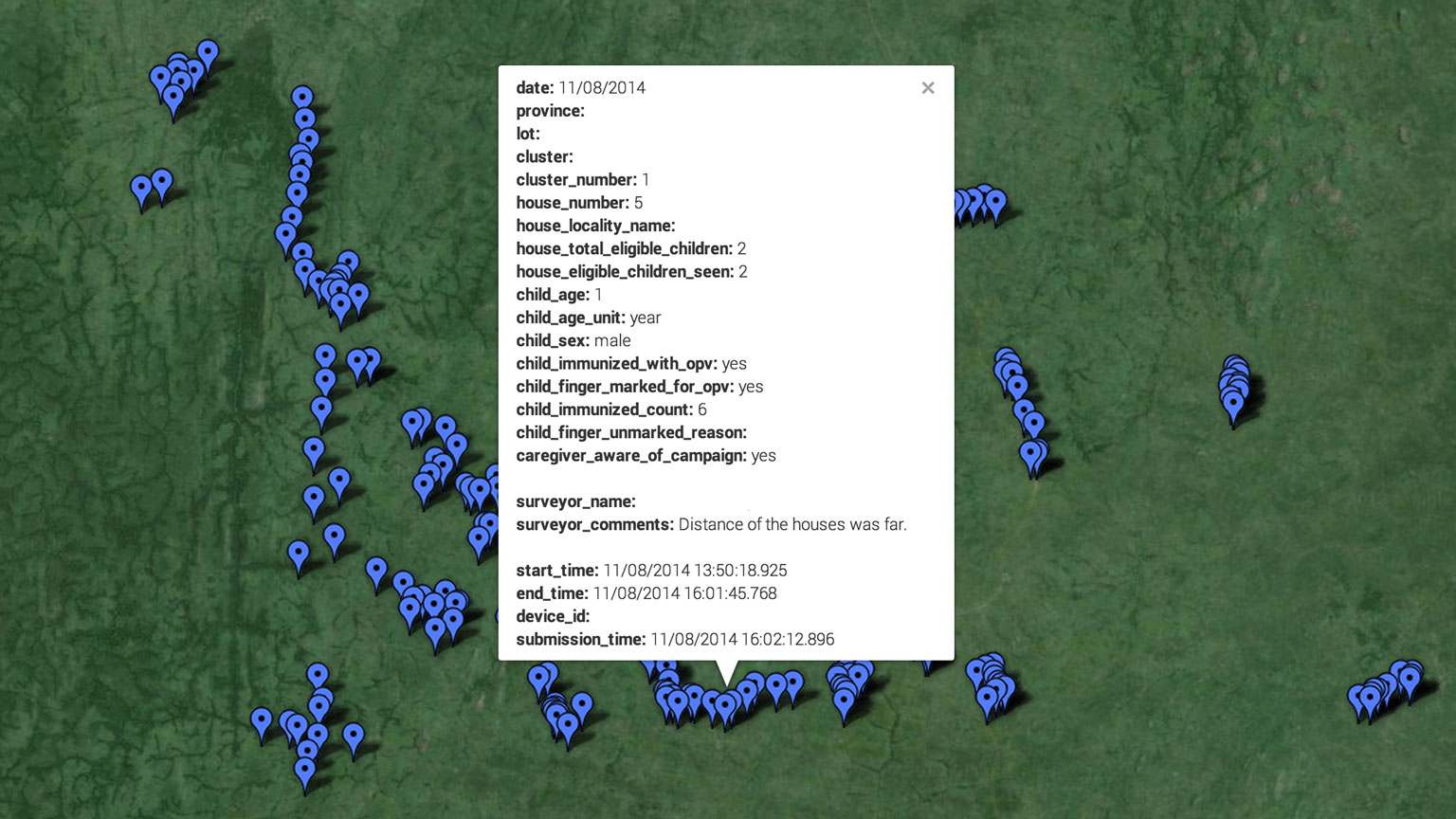The goal of the Global Polio Eradication Initiative (GPEI) is to ensure that no child suffers from the paralysis caused by polio. Great progress has been made since GPEI's foundation in 1988. Worldwide incidence of polio has fallen by 99% and some 10 million people are walking today because of GPEI's work. The global health community is now pushing to rid the world of the remaining 1% of polio cases and mobile data collection is essential to validating that this important work is done well.
To order to validate good coverage for polio vaccination, governments must send out independent monitors to check that children in the target area have been vaccinated. This rapid validation (often implemented with Lot Quality Assurance Sampling or LQAS) must be happen within days of a campaign so problems can be addressed while the necessary infrastructure is still in place.
 Children display the indelible mark on the finger they receive after a polio vaccination.
Children display the indelible mark on the finger they receive after a polio vaccination.
Areas that suffer from polio outbreaks also suffer from poor infrastructure so when this critical LQAS monitoring is done with paper, it can take months to collect, transport, digitize, and analyze the data. Even if the data can be collected and analyzed quickly, paper lacks automated accountability (e.g., GPS coordinates to prove households were visited) and data validation (e.g., branching and constraints on questions that standardize the process) so it is hard to trust the accuracy of the collected data.
eLQAS is an electronic version of LQAS that uses phones and tablets to improve rapid monitoring of polio vaccination. Implemented as a free and open-source form in ODK, eLQAS enables real time results, increased data quality, improved accountability, and easier implementation.
eLQAS was built by Nafundi, in partnership with the Bill and Melinda Gates Foundation (BMGF), and in line with the World Health Organization's (WHO) LQAS Field Manual. To enable it to be deployed with minimal technical expertise, the system consists of two easy-to-use Excel files – a collection form and an analysis tool.
The collection form is designed using our XLSForm Offline tool. Each implementing government simply edits the form in Excel to include their list of provinces, districts, lots, and clusters. Once the form is added to any standard ODK installation, the campaign can start.
During the campaign, the analysis tool allows supervisors to export and analyze resulting data from ODK. The tool automatically calculates which lots are adequately covered with vaccines. The analysis pipeline also creates beautiful real-time maps of the campaign.
 Anonymized map with real-time eLQAS results from a campaign in rural South Sudan.
Anonymized map with real-time eLQAS results from a campaign in rural South Sudan.
In partnership with South Sudan's Ministry of Health and CORE Group (AMREF, Save the Children, American Refugee Committee, CARE, and World Vision), Nafundi recently deployed eLQAS in rural South Sudan. The goal was to prove the viability of eLQAS before making the tool globally available.
The deployment took two days (one day for training, one day for data collection) and successfully surveyed 480 households with 20 surveyors and 10 Nexus 7 tablets.
Dr. Jeffrey Partridge, a Senior Program Officer at BMGF who observed the campaign, described eLQAS's ability to deliver real time results, increase data quality and accountability, and enable easier implementation in his summary report of the campaign. The report also noted how technical assistance from Nafundi helped with this first deployment.
"There are only a handful of miles of paved roads in the entire country, and many areas are simply inaccessible by ground transportation during the rainy season. After sending surveyors out to the field, decision-makers could be a month or so from knowing coverage, at which point one would likely have to wait until the next campaign to do anything about missed areas. On the other hand, the cellphone network is reasonably reliable, and we could see the results of the survey stream in directly from the field over the two-day survey."
"[eLQAS] has standardized place names and built-in checks for data quality. All of this makes analysis of the survey straight-forward; [The analysis tool] automatically lists and color-codes the lots according to coverage levels."
"For hard-to-reach areas, like much of South Sudan, this [GPS-based] accountability is extremely useful in ensuring the surveyors go to the areas in the survey. When we went into the field with the surveyors, we saw that it could take 30 minutes or more to walk in hot weather from one house to the next in order to complete the survey. GPS ensures that this difficult work is done."
"[Surveyors] had never done LQAS, and had never used tablet computers. The surveyors were universally excited to use the new technology, and figured out how to use the tablets quickly. Most of the questions and difficulties in the training had to do with LQAS in general, rather than how to use the apps."
"The field deployment over the next few days went smoothly. All surveyors completed their lots, no tablets were lost, we had all of the data in and analyzed before the surveyors came back to de-brief. We found that battery life was not an issue ([the tablets] last for a few days – long enough to complete the survey). For areas without cell-phone coverage, the surveyors could send in results later on when they were in range."
"One key to a successful deployment was having a technical person on ground (in our case, Nafundi). While ODK is user-friendly, it was extremely useful to have an expert on ground to answer questions about data access, configure tablets with local SIM cards, tweak the forms, and configure ODK to make data available in an easy-to-analyze format."
Nafundi has worked closely with BMGF, CORE Group, and WHO to make a turnkey version of eLQAS available at https://polio.github.io/elqas. Our goal is to ensure that all organizations who wish to collect accurate real-time polio vaccination data can do so quickly, easily, and as always, by themselves. Need help? Contact Nafundi's data collection experts to get started.
In early 2018, polio virus was detected in the sewers of Mogadishu, Somalia and the government moved quickly to vaccinate the country's children in order to prevent a potential outbreak. A vaccination campaign targeting more than 726,000 children was launched in the Banadir and Lower and Middle Shabelle regions. The campaign was carried out by some 3,500 staffers and Nafundi assisted by enabling real-time tracking of vaccination coverage using ODK. Read more.
Fayaz Jatoi is the Coordinator of the Emergency Operations Centre (EOC) for Polio Eradication in Sindh, Pakistan. In this guest post, Fayaz describes why AFP surveillance is critical to polio eradication and how an SMS-based reporting system for private care provider helps. Read more.
This position has been filled. Thanks to everyone who applied! Read more.